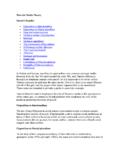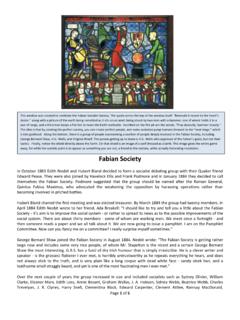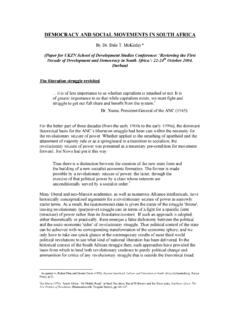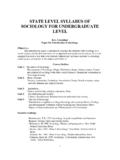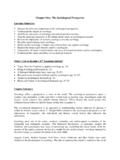Transcription of Patient Safety and the “Just Culture”: A Primer for …
1 Medical Event Reporting System for Transfusion MedicinePatient Safety and the Just Culture :A Primer for health care ExecutivesApril 17, 2001 Prepared by David Marx, JDDavid Marx Consultingin support of Columbia UniversityFunded by a grant from the National Heart, Lung, and Blood InstituteNational Institutes of health (Grant RO1 HL53772, Harold S. Kaplan, MD, Principal Investigator)Copyright 2001by the Trustees of Columbia University in the City of New YorkAll Rights ReservedMay be reproduced in whole or in part for noncommercial use providedthat the following appears on the first page of the reproduction: Prepared by David Marx, JD, for Columbia University under a grantprovided by the National Heart, Lung, and Blood Institute Patient Safety and the Just Culture: A Primer For health care Executives Medical Event Reporting System Transfusion Medicine (MERS-TM) 4/17/01 2 I.
2 executive Summary .. 3 II. The Problem Statement .. 4 III. An Introduction to Disciplinary System Theory .. 5 A. The Four Evils .. 5 1. Human Error .. 6 2. Negligent Conduct .. 6 3. Reckless 7 4. Intentional Rule Violations .. 7 B. Application to Transfusion Scenarios .. 7 1. Scenario 1- The Memory 7 2. Scenario 2 The Misplaced Tube .. 9 3. Scenario 3 The Reckless Technologist .. 11 C. Disciplinary Decision-Making Strategies .. 13 1. Outcome-Based Disciplinary Decision-Making .. 13 2. Rule-Based Disciplinary Decision-Making .. 14 3. Risk-Based Disciplinary Decision-Making .. 16 D. Distinguishing Compensatory and Punitive 18 IV. Where We Stand Today .. 19 A. The Regulatory Perspective.
3 19 B. The Corporate Perspective .. 20 C. A Note on Repetitive 23 D. A Note on Qualification .. 24 V. Your Task as a health care 25 VI. Conclusion .. 27 Patient Safety and the Just Culture: A Primer For health care Executives Medical Event Reporting System Transfusion Medicine (MERS-TM) 4/17/01 3 I. executive Summary As part of the ongoing effort to improve transfusion Safety , MERS-TM provides a standardized means of organized data collection and analysis of transfusion errors, adverse events, and near misses. Its effectiveness depends on the willingness of individuals to report such information. This report is designed as an aid for health care executives, labor attorneys, labor leaders, and human resource specialists who must struggle with what to do, in the disciplinary context, with an erring health care professional.
4 It is a guide for more thoroughly understanding the problems posed by current disciplinary approaches, and to possible changes in your current disciplinary policies as you contemplate implementation of a new reporting and investigation system. Today, most corporate disciplinary systems literally prohibit human error. That is, mere human error, when coupled with harm to a Patient , will raise the specter of social condemnation and disciplinary action. Advances in Patient Safety , especially when involving the management of human error, depend upon our collective ability to learn from our mistakes whether they are near misses or mistakes resulting in actual harm to a Patient . To promote a culture in which we learn from our mistakes, organizations must re-evaluate just how their disciplinary system fits into the equation.
5 Disciplining employees in response to honest mistakes does little to improve overall system Safety . Yet, mishaps accompanied by intoxication or malicious behavior presents an obvious and valid objection to today s call for blame-free error reporting systems. It is through the lessons of our everyday errors that we can design our work environment to be less error prone and more error tolerant. Few people are willing to come forward and admit to an error when they face the full force of their corporate disciplinary policy, a regulatory enforcement scheme, or our onerous tort liability system. To collect productive investigative data, we must promote a culture in which employees are willing to come forward in the interests of system Safety .
6 Yet, no one can afford to offer a blame-free system in which any conduct can be reported with impunity as society rightly requires that some actions warrant disciplinary or enforcement action. It is the balancing of the need to learn from our mistakes and the need to take disciplinary action that this report addresses. Ultimately, it will help you answer the question: Where do you draw the disciplinary line? Patient Safety and the Just Culture: A Primer For health care Executives Medical Event Reporting System Transfusion Medicine (MERS-TM) 4/17/01 4 II. The Problem Statement On October 12, 1999, Dr. Lucian Leape, a professor at the Harvard School of Public health , gained the attention of a US Congressional subcommittee when he briefed them on the state of human error management in the US medical The numbers are staggering: an estimated one million people injured by errors in treatment at hospitals each year in the US, with an estimated 120,000 deaths arising from those A number three times greater than those who die in automobile accidents and 1000 times greater than those who die in commercial aircraft accidents, these errors are accompanied by an estimated $33 billion price tag.
7 As a result of a punitive work environment and because hospital personnel (as well as most of the public) tend to regard health care provider errors as evidence of personal carelessness, most hospitals are unaware of the extent of their errors and injuries. Dr. Leape reported that only 2 to 3% of major errors are reported through hospital incident reporting systems. health care workers often report only what they cannot conceal. Dr. Leape went on to tell Congress that health care organizations must make error prevention a major strategic objective, and that hospitals should eliminate punitive error reporting systems so that reporting can be made safe for employees. Systems should be established to track error and the effectiveness of corrective measures.
8 Regulators must become a force for error reduction rather than a force for error concealment. We must all be educated regarding the central roles of system design and corporate responsibility in managing human error. Ultimately, Dr. Leape said, the single greatest impediment to error prevention is that we punish people for making mistakes. It is this very bold statement that this Primer addresses. Just what is the role of punitive sanction in the Safety of our health care system? Does the threat and/or application of punitive sanction as a remedy for human error help or hurt our system Safety efforts? 1 Testimony, United States Congress, House Committee on Veterans Affairs, Dr.
9 Lucian L. Leape, MD, October 12, 1997. 2 The later released IOM report put the number of deaths at between 44,000 and 98,000 deaths in the US each year. Patient Safety and the Just Culture: A Primer For health care Executives Medical Event Reporting System Transfusion Medicine (MERS-TM) 4/17/01 5 III. An Introduction to Disciplinary System Theory Determining when a health care professional warrants disciplinary sanction requires that we first attempt to define, or at least better describe, what we mean by disciplinary action. In our context, we will think of disciplinary action as harm dispensed by an authority to deter future undesirable conduct. Quite simply punishment. Punishment that harms directly through its sanction (fine or license action) or, perhaps even worse, the often-resulting public condemnation of the individual involved.
10 A. The Four Evils Four behavioral concepts are important to an understanding of the inter-relationship between discipline and Patient Safety : human error, negligence, intentional rule violations, and reckless conduct. These behavioral categories are presented here because they are the principal labels we use socially, and legally, to describe blameworthy conduct. One or more of these behavioral categories will be applied in most mishap investigations, and the label often determines when disciplinary sanction is appropriate. The question we will specifically address is whether all or only some of these labels warrant disciplinary sanction in the post-mishap setting. Human Error Negligent Conduct Reckless Conduct Knowing Violations Patient Safety and the Just Culture: A Primer For health care Executives Medical Event Reporting System Transfusion Medicine (MERS-TM) 4/17/01 6 As you will see in the examples that follow, the four evils are not mutually exclusive; they overlap each other in definition - and they can all occur in the same mishap.


